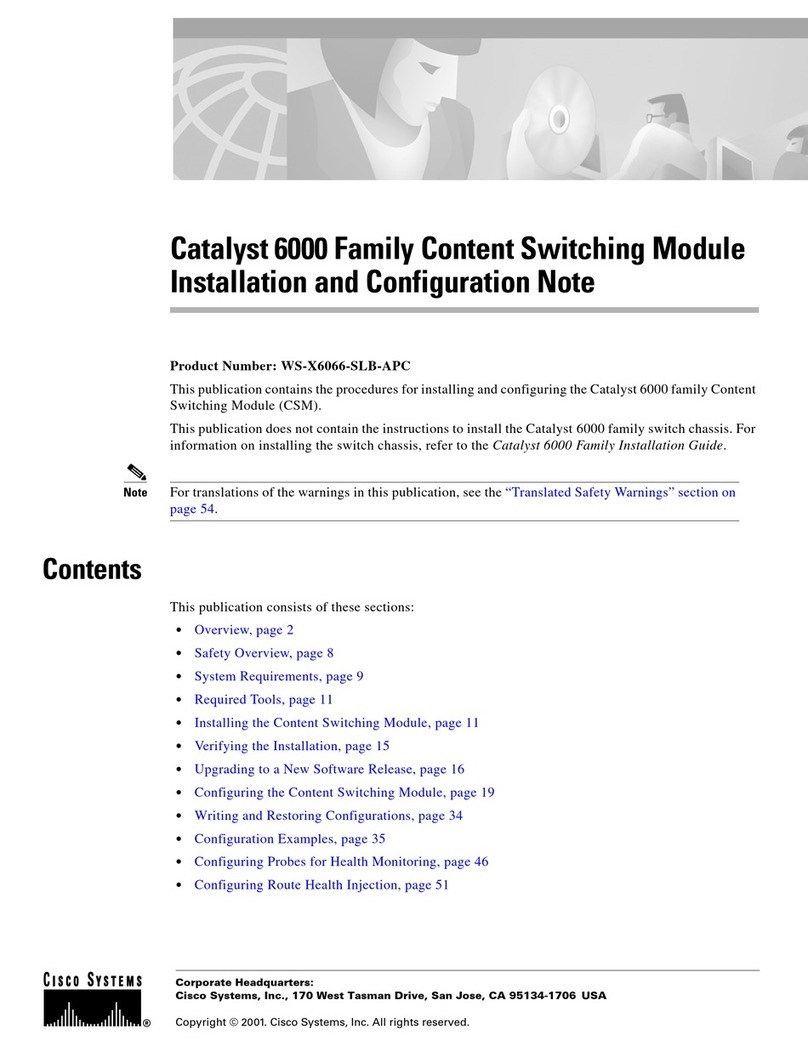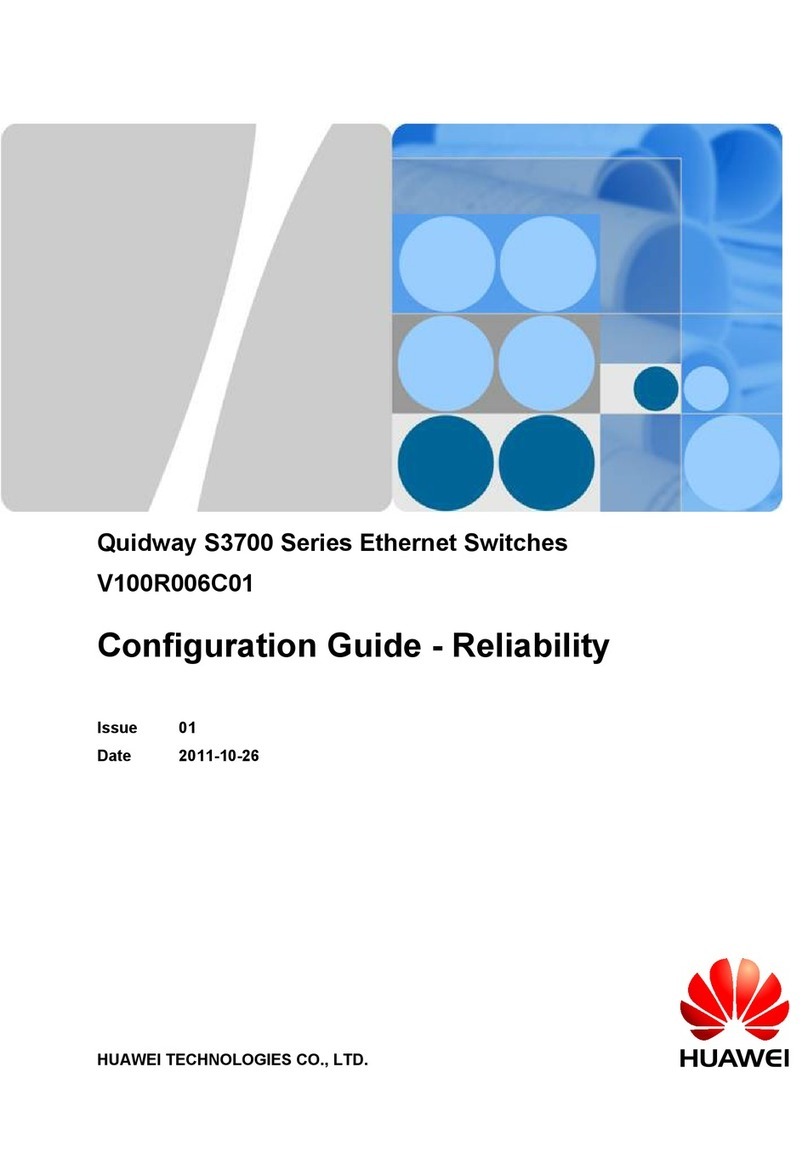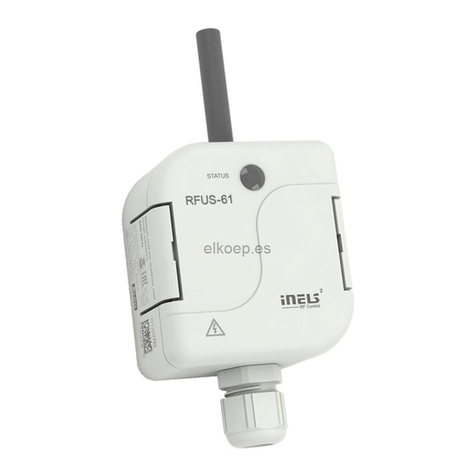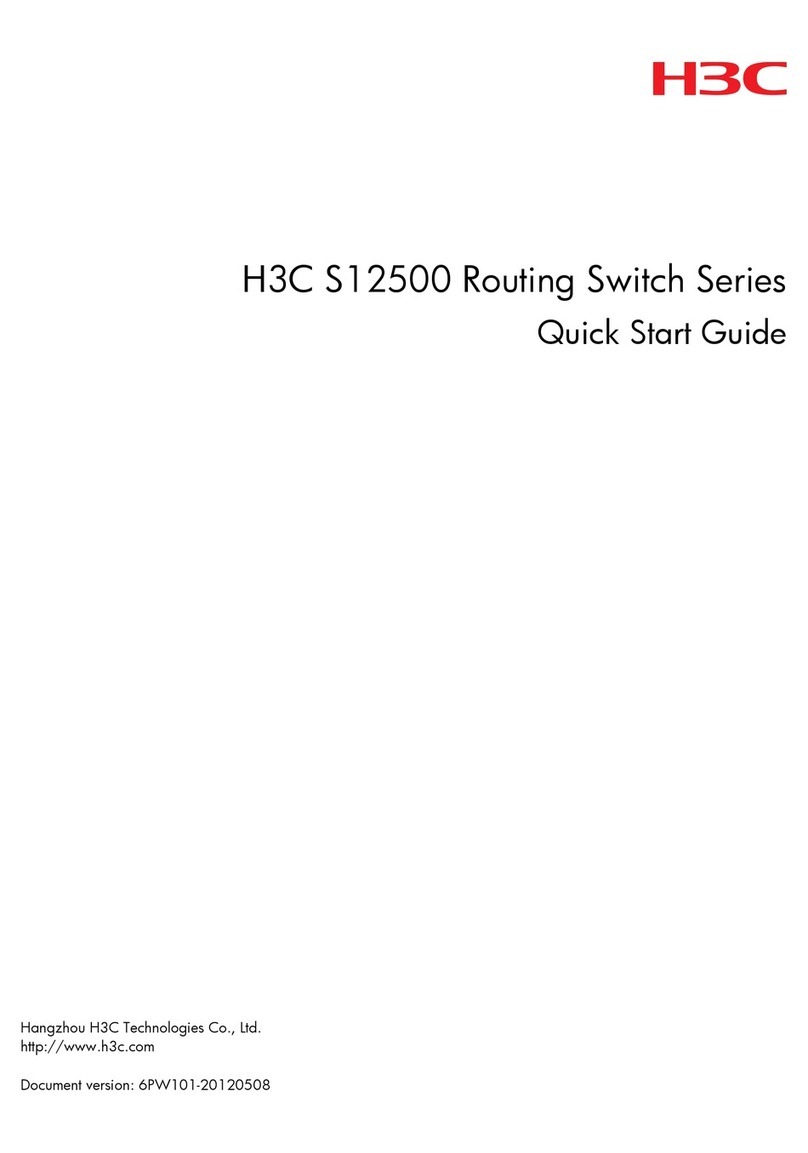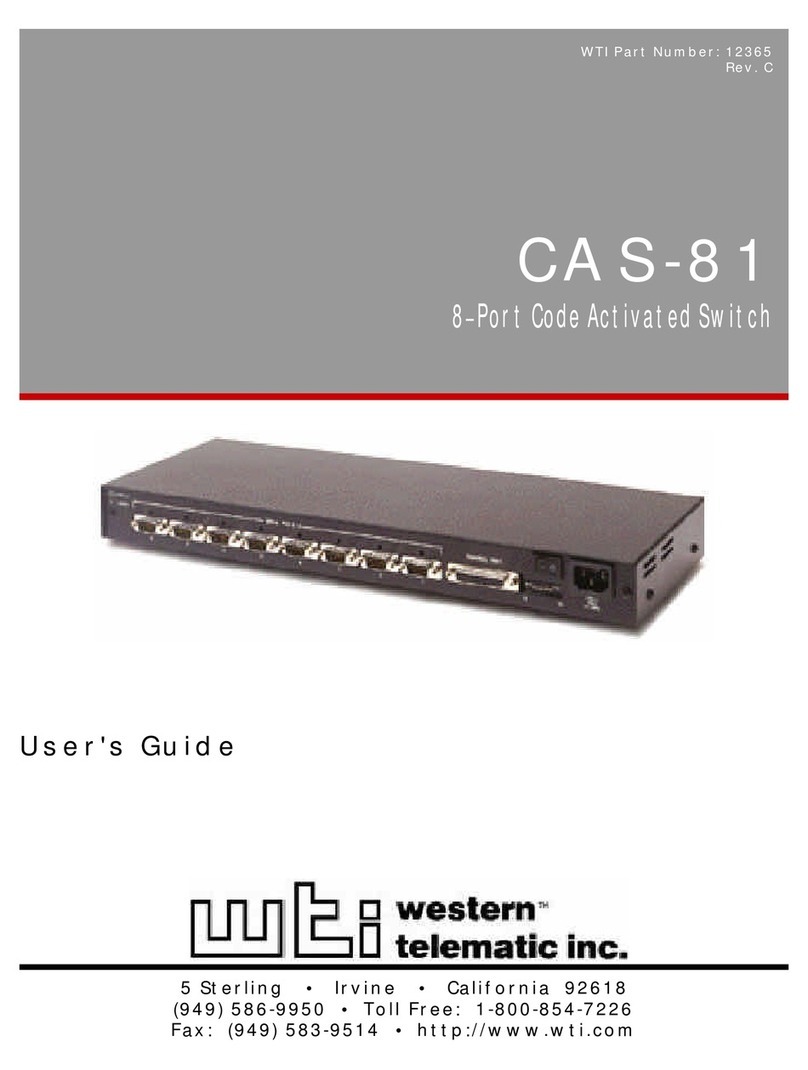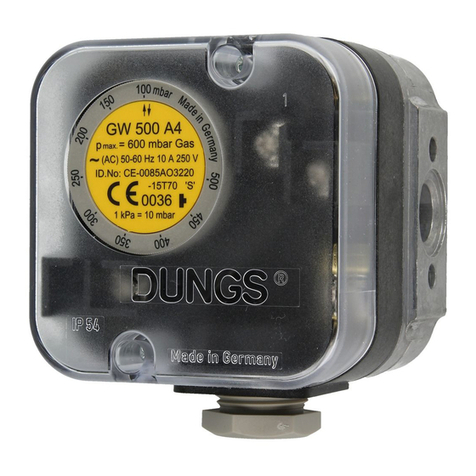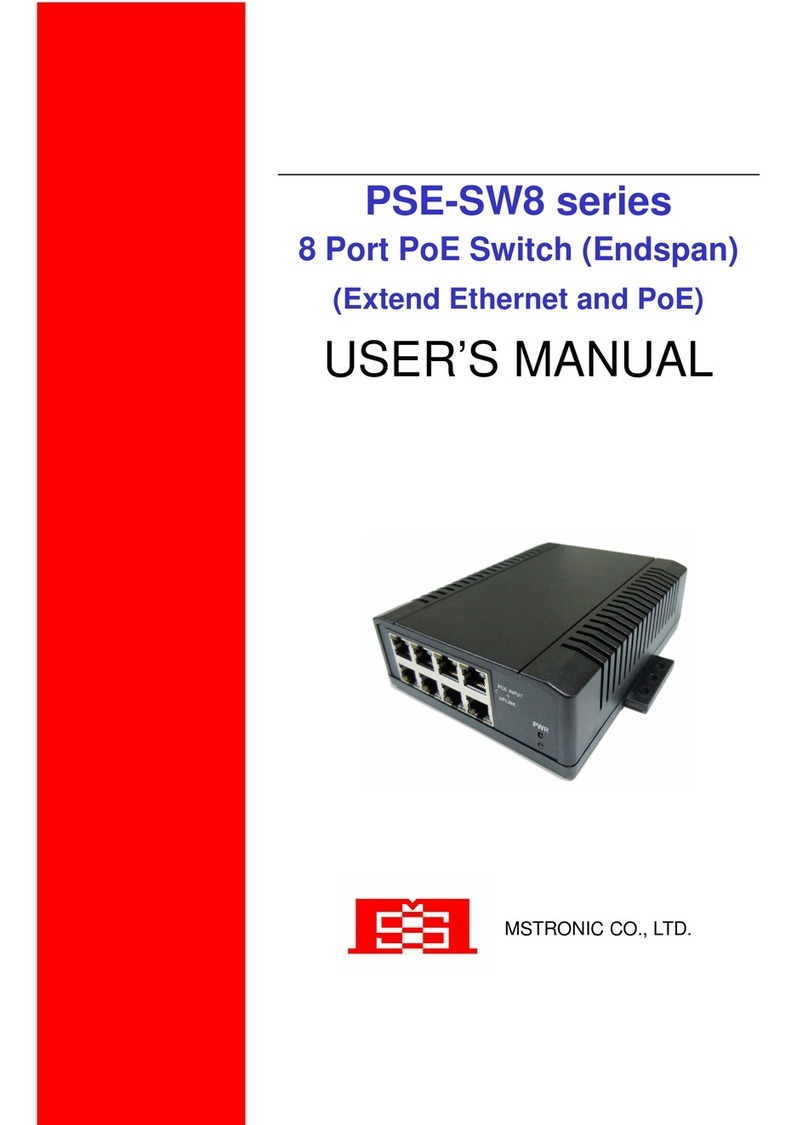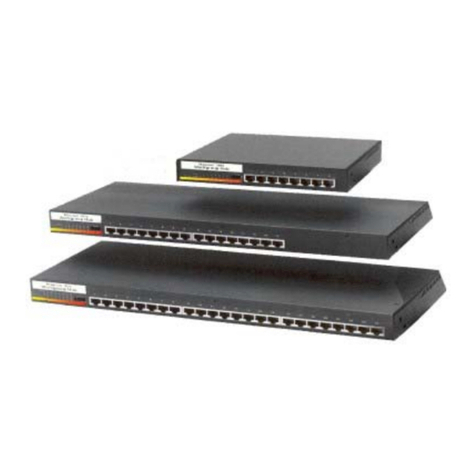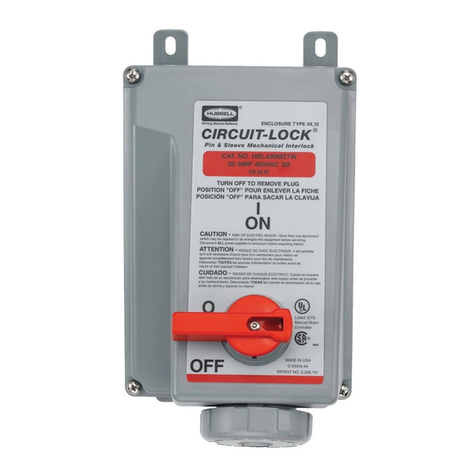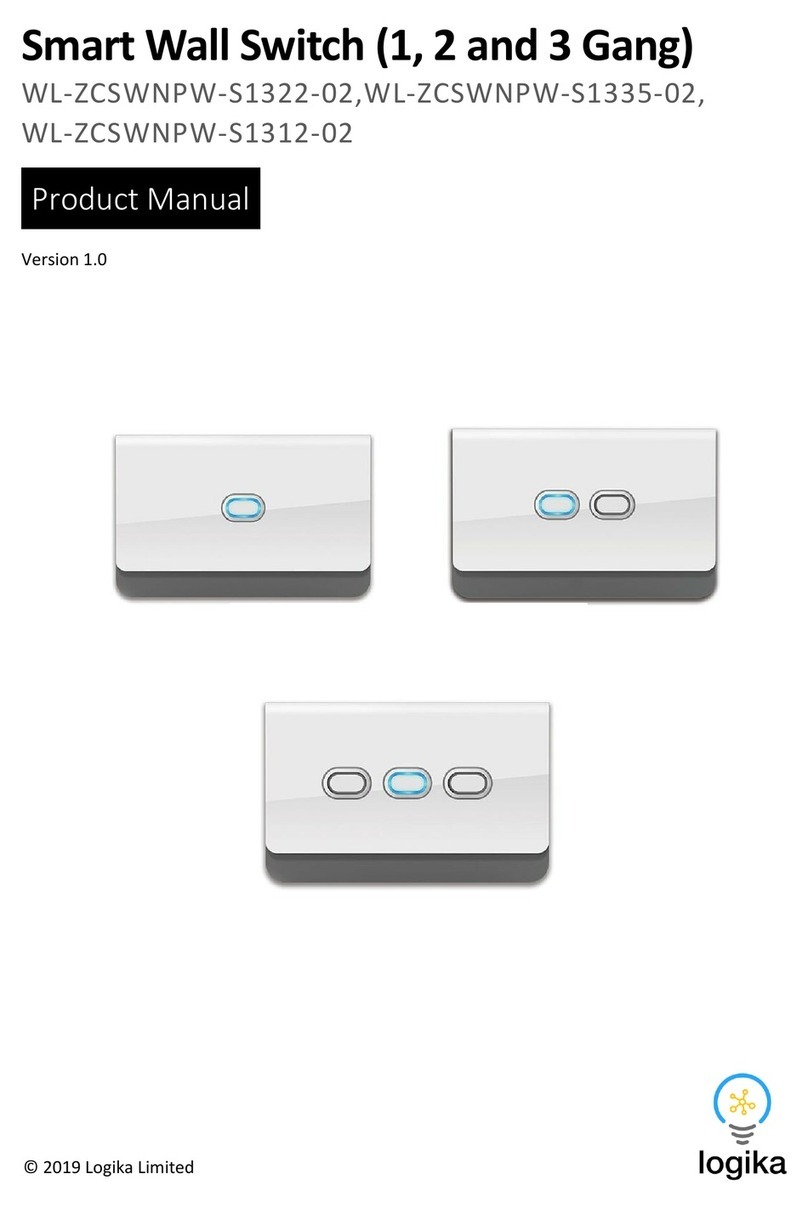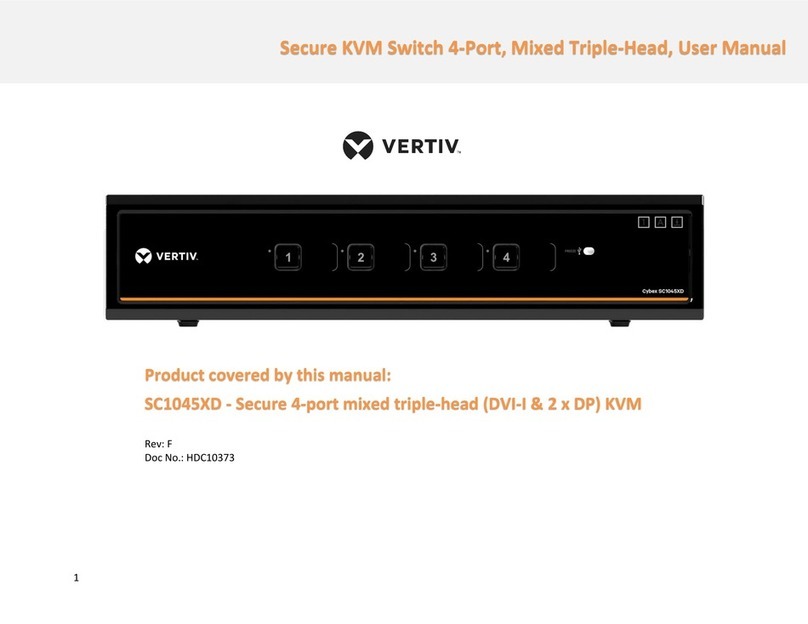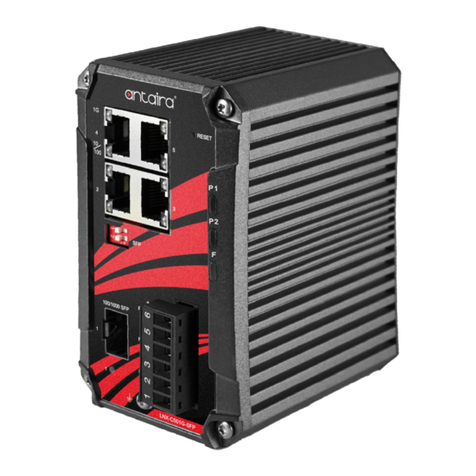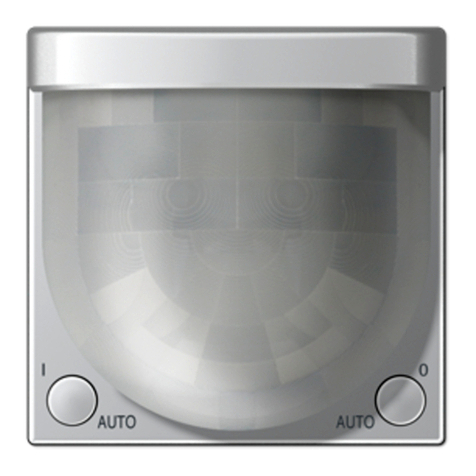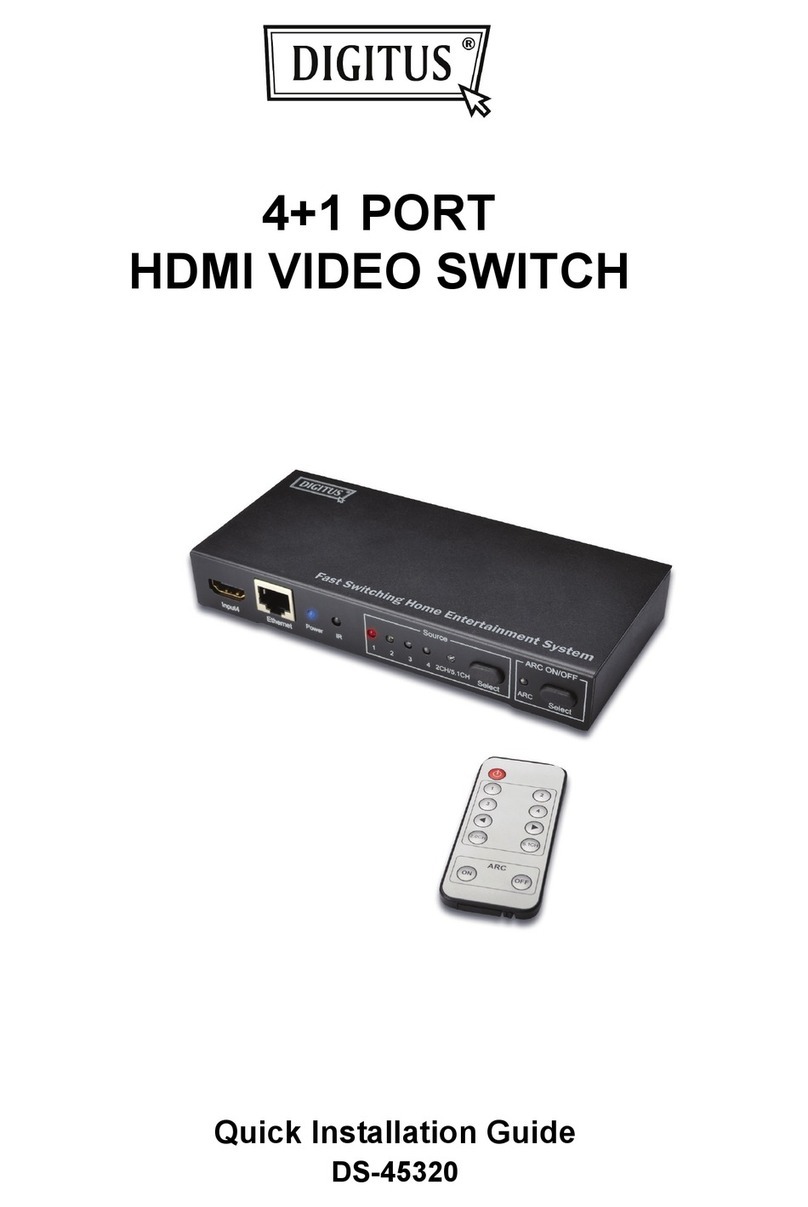General DataComm Xedge 6000 Series Manual

+DUGZDUH#,QVWDOODWLRQ
Xedge Chassis Systems
Xedge Slot Controllers
Xedge Switch Fabric
Line Interface Modules
Node Timing Modules
System Management Modules
Cables & Peripherals
032R440-000
Issue 17
April 2016
;HGJH#9333

Copyright
©2016 General DataComm, Inc. ALL RIGHTS RESERVED.
This publication and the software it describes contain proprietary and confidential information. No part of this
document may becopied, photocopied, reproduced, translated or reduced to any electronic or machine-readable
format without prior written permission of General DataComm, Inc. The information in this document is subject
to change without notice. General DataComm assumes no responsibility for any damages arising from the use
of this document, including but not limited to, lost revenue, lost data, claims by third parties, or other damages.
If you have comments this manual, contact General dataComm, Inc. at http://www.gdc.com.
Trademarks
All brand or product names are trademarks or registered trademarks of their respective companies or
organizations.
Documentation
Revision History of GDC P/N 032R440-000
Related Publications
-### is the hardware revision (-000,-001, etc.)
-V### is the Xedge or ProSphere software version (-V440,V53x,V620,V73x, etc.)
In addition to the publications listed above, always read Patch and Release Notes for your products.
Browse to http://www.gdc.com and follow the Library link for the latest Xedge/ProSphere documentation.
Issue Date Description of Change
1 June 2009 Consolidates and updates hardware setup andinstallation instructionsfor all Xedge
modules supported under V6.2 or V7.x switch code. (Formerly in Software,
Hardware, and Chassis manuals: 032R401-V7x, 032R440-V620, 032R410-000)
2 August 2009 Minor updates/corrections.
3 September 2010 Added LIMs; general updates and corrections.
4 October 2010 Added LIMs; general updates and corrections.
5 June 2011 Added ASIO LIM, new LPMs.
6 July 2011 Minor updates/corrections.
7 October 2011 Clarifications and corrections.
8 February 2012 Added pinout information for LIM cable 027H703-008 (T1/E1 LIMs)
9/10 June/August 2012 Added rack mounting information; updates to ANA LIM with E&M plugin card.
11/12 Sept/Oct 2012 Added T1/E1 and AVM-E&M pinouts; APL certification. Revised IMA/IMA+ LIMs
13/14/15 May/Sept/Nov 2013 Minor corrections and clarifications; Added specifications.
16/17 May 2015/April 2016 Added features of Xedge Version 7.4.X.
Description Part Number
Xedge / ProSphere Deployment Guide (for military systems) Contact GDC
Xedge / ProSphere Security Administration Guide (for all Xedge systems) 032R298-000
Xedge / ProSphere Quick Reference (for all Xedge systems) 032R299-000
Xedge Hardware Installation Guide (for all Xedge systems) 032R440-000
Xedge 6000 for MSPx Applications Version 7.4.X Software Configuration Guide
Xedge 6000 for MSPx Applications Version 7.4.X Release Notes 032R401-V74X
032R901-V74X
Xedge 6000 for ATM Applications Version 6.2.X Software Configuration & Status Guide
Xedge 6000 for ATM Applications Version 6.2.X Release Notes, Cumulative Patch Notes 032R400-V62X
032R901-V62XXX
ProSphere NMS Version 6.0.XUser Guide (for all Xedge 6000 systems)
ProSphere NMS Version 6.0.XInstallation & Release Notes (CORE, AEM, GFM, SPM, RTM, XPM) 032R610-V60X
032R906-V60X

032R440-000 Xedge6000Hardware iii
Issue 17 Installation & Setup Guide
Table of Contents
Preface
Safety Information ................................................................................................................. viii
Compliance .............................................................................................................................. ix
Government Certifications ..................................................................................................x
Before You Begin .................................................................................................................... xi
Site Requirements...............................................................................................................xi
Installation & Connectivity ................................................................................................xi
Accessing the Xedge Switch ..............................................................................................xi
Support Services and Training................................................................................................ xii
Corporate Client Services..................................................................................................xii
Factory Direct Support & Repair.......................................................................................xii
Contact Information...........................................................................................................xii
Chapter 1: Xedge Hardware Overview
Identifying Xedge Modules..............................................................................................1-1
Xedge Software Versions.................................................................................................1-1
Major Xedge 6000 Hardware Components............................................................................ 1-2
Xedge Chassis Systems ....................................................................................................1-2
Xedge Switch Fabric Modules .........................................................................................1-2
System Modules ...............................................................................................................1-2
Slot Controller Overview....................................................................................................... 1-4
Xedge 6000 for MSPx Applications.................................................................................1-4
Xedge 6000 for ATM Applications..................................................................................1-6
Xedge LIM Overview ............................................................................................................ 1-8
Xedge Cabinets, Chassis, Cables......................................................................................... 1-16
Chapter 2: Xedge Chassis Systems
Overview................................................................................................................................ 2-1
Xedge 6002 Chassis............................................................................................................... 2-2
Xedge 6002 Technical Specifications ..............................................................................2-2
Module Installation...........................................................................................................2-2
Xedge 6002 Front/Rear Panel Features............................................................................2-3
Rack Mounting the Xedge 6002.......................................................................................2-4
Air Flow Requirements ....................................................................................................2-4
Power Supply....................................................................................................................2-4
Xedge 6002 Connections..................................................................................................2-5
Xedge 6002 Ground Connections.....................................................................................2-6
Xedge 6002 System Management Connections...............................................................2-7
Xedge 6002 Maintenance.................................................................................................2-8
Xedge 6160 Chassis............................................................................................................... 2-9

iv Xedge 6000 Hardware 032R440-000
Installation & Setup Guide Issue 17
Table of Contents
Xedge 6160 Technical Specifications ..............................................................................2-9
Module Installation...........................................................................................................2-9
Front/Rear Panel Features ..............................................................................................2-10
Installing the Xedge 6160...............................................................................................2-11
Xedge 6160 Power Supplies...........................................................................................2-13
Xedge 6160 Connections................................................................................................2-14
Ground Connections.......................................................................................................2-16
Xedge 6280 Chassis............................................................................................................. 2-17
Technical Specifications.................................................................................................2-17
Module Installation.........................................................................................................2-17
Front/Rear Panel Features ..............................................................................................2-18
Installing the Xedge 6280...............................................................................................2-19
Air Flow..........................................................................................................................2-20
Power Input Modules (PIMs).........................................................................................2-20
Fan Tray Assembly.........................................................................................................2-21
Power Supplies ...............................................................................................................2-21
Craft and Alarm Connections.........................................................................................2-23
AC Chassis Power Connections.....................................................................................2-23
DC Chassis Power Connections.....................................................................................2-24
Ground Connections.......................................................................................................2-26
Xedge 6640/6645 Chassis.................................................................................................... 2-27
Xedge 6640/6645 Technical Specifications ...................................................................2-27
Xedge 6640/6645 Front Panel........................................................................................2-29
Xedge 6640/6645 Chassis Installation ...........................................................................2-32
Fan Tray Assembly.........................................................................................................2-35
Xedge 6640/6645 Power Supplies..................................................................................2-35
Xedge 6640 AC Power Connections..............................................................................2-37
Xedge 6645 DC Power Connections..............................................................................2-37
Xedge 6640/6645 Ground Connections .........................................................................2-39
Xedge 6640/6645 System Management Connections....................................................2-40
Alarm Connections.........................................................................................................2-41
Status Input Connections................................................................................................2-41
Module Installation.........................................................................................................2-41
Chapter 3: Switch Fabric and V6.2 Controllers
Installation Overview............................................................................................................. 3-1
Hardware Installation Guidelines.....................................................................................3-2
Basic Installation Procedure.............................................................................................3-2
Rotary Switch Setup (All Controllers)................................................................................... 3-3
Slot Controller Setup.............................................................................................................. 3-4

032R440-000 Xedge6000 Hardware v
Issue 17 Installation & Setup Guide
Table of Contents
Front Panel Indicators.......................................................................................................3-4
CE Hardware Settings ......................................................................................................3-5
ETH Hardware Settings....................................................................................................3-6
Switch Fabric Setup ............................................................................................................... 3-8
Front Panel Indicators.......................................................................................................3-8
XH/XS Switch Fabric Hardware Setup............................................................................3-9
XM Switch Fabric Module.............................................................................................3-11
Chapter 4: V7.x Packet Controllers
Installation Overview............................................................................................................. 4-1
Hardware Installation Guidelines.....................................................................................4-2
Basic Installation Procedure.............................................................................................4-2
ISG2 Controller Overview..................................................................................................... 4-3
ISG2 Hardware Settings ..................................................................................................4-4
ISG2 Slot Locations..........................................................................................................4-5
PCX/PCX-2 Controller Overview.......................................................................................... 4-6
PCX/PCX-2 Hardware Settings .......................................................................................4-7
PCX/PCX-2 Slot Locations..............................................................................................4-8
PCX/PCX-2 Assembly.....................................................................................................4-9
PCL Controller Overview.................................................................................................... 4-11
PCL Hardware Settings .................................................................................................4-12
PCL Slot Locations.........................................................................................................4-13
PCL Assembly................................................................................................................4-14
PCE Controller Overview.................................................................................................... 4-15
PCE Hardware Settings .................................................................................................4-16
PCE Slot Locations.........................................................................................................4-17
PCE Assembly................................................................................................................4-18
Chapter 5: Line Interface Modules
Installation Overview............................................................................................................. 5-1
Installation Guidelines......................................................................................................5-2
LIM Removal/Replacement .............................................................................................5-2
OC-N / STM-N Overview...................................................................................................... 5-4
Hardware Setup ................................................................................................................5-4
OC-N/STM-N Applications .............................................................................................5-5
ASIO LIM.............................................................................................................................. 5-6
Hardware Setup ................................................................................................................5-6
Analog Voice LIM................................................................................................................. 5-7
Hardware Setup ................................................................................................................5-7
T1/E1 MP16 LIM................................................................................................................. 5-11

vi Xedge 6000 Hardware 032R440-000
Installation & Setup Guide Issue 17
Table of Contents
Hardware Setup ..............................................................................................................5-11
T1/E1 HDCC LIM ............................................................................................................... 5-14
Hardware Setup ..............................................................................................................5-14
DS3-2C Overview................................................................................................................ 5-15
E3-2C Overview................................................................................................................... 5-16
DS1-2CS and DS1-4CS Overview ...................................................................................... 5-17
Hardware Settings...........................................................................................................5-18
E1-2CS and E1-4CS LIM Overview.................................................................................... 5-19
Hardware Settings...........................................................................................................5-20
155 Series LIMs Overview .................................................................................................. 5-21
155 Series Jumper Settings.............................................................................................5-24
155E-2 STM-1 Electrical LIM Overview............................................................................ 5-25
HSSI (DTE/DCE) LIM Overview ....................................................................................... 5-27
Serial I/O (SI-2C/SI-4C) LIM Overview............................................................................. 5-29
LCE-16 LIM Overview........................................................................................................ 5-32
DSX-1 and E1 IMA/IMA+ LIM Overview ......................................................................... 5-36
Class A EMI-RFI Suppression Requirements...................................................................... 5-43
Chapter 6: Network Timing Modules
Overview................................................................................................................................ 6-1
Installation Guidelines......................................................................................................6-1
Basic Installation Procedure.............................................................................................6-1
DS1 Node Timing Module (NTM-DS1)................................................................................ 6-2
E1-Node Timing Module (NTM-E1)..................................................................................... 6-4
Chapter 7: System Management Modules
Overview................................................................................................................................ 7-1
Installation Guidelines......................................................................................................7-1
Installation Procedure.......................................................................................................7-1
SMM Switches and Indicators..........................................................................................7-2
SMM Craft Port Connectors.............................................................................................7-3
Alarm Info Connector.......................................................................................................7-4

032R440-000 Xedge 6000 Hardware vii
Issue 17 Installation & Setup Guide
Preface
Scope of this Manual
This manual provides a detailed description of the front panel features, hardware setup and
installation procedures for the Xedge 6000 hardware systems: Xedge 6000 for multiservice packet
exchange applications (MSPX), and the legacy Xedge 6000 for ATM applications (Version 6.2.X
All information in this document applies to these components, except where noted. This document
consolidates and updates hardware information previously issued in GDC P/N 032R401-V7.X,
032R410-000 and GDC P/N 032R440-V62X.
• Refer to the latest Xedge 6000 for MSPx Applications Version 7.x Config & Diag Guide
(032R401) to configure Xedge packet controllers and their LIMs.
• Refer to the latest Xedge 6000 for ATM Applications Version 6.2.x Config & Diag Guide
(032R400) to configure legacy Xedge cell/adaptation controllers and their LIMs.
• Always read the latest software release and patch notes supporting your Xedge modules for
a list of new features, bug fixes, known issues, installation requirements, etc.
•Related Publications are listed on the inside front cover of this document.
This information is intended for qualified network operators and administrators who are
experienced in setting up and managing MPLS and ATM traffic and signaling in Xedge 6000
networks. Wiring must comply with the local electrical codes in your area that govern the
installation of electronic equipment. A background knowledge of voice and data
telecommunications, network architecture and terminology is assumed.
The information contained in this manual has been carefully checked and is believed to be entirely
reliable. As General DataComm continually improves the reliability, function and design of its
products, it is possible that some information may not be current. Contact General DataComm, your
sales representativeor point your browser to http://www.gdc.com for the latest information.
Manual Organization
This manual is divided into chapters that describe installation instructions, front panel indicators
and connectors, and jumper and switch settings of the various Xedge modules. When using the
digital version of this manual, click on any link (shown in blue text) to jump to that section.
Chapter 1, Xedge Hardware Overview
Chapter 2, Xedge Chassis Systems
Chapter 3, Switch Fabric and V6.2 Controllers
Chapter 4, V7.x Packet Controllers
Chapter 5, Line Interface Modules
Chapter 6, Network Timing Modules
Chapter 7, System Management Modules

Preface Safety Information
viii Xedge6000Hardware 032R440-000
Installation & Setup Guide Issue 17
Safety Information
This manual should be read in its entirety and all procedures completely understood before
installing or operating the unit, including all notes, cautions and warnings (examples below). The
CAUTION, WARNING, and DANGER statements that appear throughout this manual are
intended to provide critical information for the safety of both the service engineer and operator.
These statements also enhance equipment reliability. The following definitions and symbols for
CAUTION, WARNING, and DANGER as they are used comply with ANSI Z535.2, American
National Standard for Environmental and Facility Safety Signs, and ANSI Z535.4, Product Safety
Signs and Labels, issued by the American National Standards Institute. .
Safety Guidelines
• Always use caution and common sense, especially when unsafe conditions or potentially
hazardous voltages are present.
• Repairs must be performed by qualified service personnel only.
• To reduce the risk of electrical shock, do not operate equipment with the cover removed.
• Never install telephone jacks in a wet location unless the jack is designed for that location.
• Never touch uninsulated telephone wires or terminals unless the telephone line is
disconnected at the network interface.
• Never install telephone wiring during an electrical storm.
Antistatic Precautions
This product may contain static-sensitive devices that are easily damaged by ESD (electrostatic
discharge). ESD occurs when a person whose body hasbuilt up static electricity touches a computer
component. ESD can cause computer components to fail. Take proper handling, grounding and
precautionary ESD measures when installing parts or cards. Keep parts and cards in antistatic
packaging when not in use or during transport. If possible, use antistatic pads on floor and
workbench. When handling components, always use an antistatic wrist strap connected to a
grounded equipment frame or chassis. If a wrist strap is not available, periodically touch an
unpainted metal surface on the equipment. Never use a conductive tool, like a screwdriver or a
paper clip, to set switches.
Note Indicates a note. It is something you should be particularly aware of; something not readily apparent.
A note is typically used as a suggestion.
Note IMPORTANT! Indicates an emphasized note. It is something you should be particularly aware of,
something not readily apparent. An Important Note is typically used to prevent equipment damage.
CAUTION indicates conditions or practices that can cause damage to equipment or loss of data.
WARNINGindicates an imminently hazardous situation which, if not avoided, may result in minor
to moderate injury. It may also be used to alert against unsafe practices.
DANGERindicates an imminently hazardous situation which, if not avoided, will result in deathor
serious injury.

Preface Compliance
032R440-000 Xedge 6000 Hardware ix
Issue 17 Installation & Setup Guide
Compliance
FCC Part 68
Connection of data communications equipment to the public telephone network is regulated by
FCC Rules and Regulations. This equipment complies with Part 68 of these regulations which
require all of the following.
For single or multi-line equipment that connects to the telephone network via a plug and jack, the
plug and jack must comply with the FCC Part 68 rules. This device is designed to be connected to
the telephone or premises wiring, using a compatible modular jack which is Part 68 compliant. See
installation chapter for details.
If the unit causes harm to the telephone network, the telephone company may discontinue your
service temporarily and if possible, you will be notified in advance. If advance notice is not
practical, you will be notified as soon as possible and will be advised of your right to file a
complaint with the FCC. The telephone company may change its communication facilities,
equipment, operations and procedures where reasonably required for operation. If so, the telephone
company will notify you in writing. Any other repair or modification by a user voids the FCC
registration and the warranty.
• The APEX DDS1 has a DSX-1 interface. To use the public telephone network, it must be
connected to a registered CSU.
• To connect the APEX DDS1 to the public telephone network the customer is required to
provide the following information:
FCC Registration Number: AG6USA-23156-XD-N
Telephone Company jack type: Provided by the registered CSU.
Facility Interface Codes: T1 Interface - 04DU9-BN, 04DU9-DN, 04DU9-1KN, 04DU9-1ZN
Service Order Code: T1 Interface - 6.0N
Industry Canada Notification
The Industry Canada label identifies certified equipment. This certification means that the
equipment meets telecommunications network protective, operation and safety requirements as
prescribed in the appropriate Terminal Equipment Technical Requirements document(s). The
Department does not guarantee the equipment will operate to the user's satisfaction.
Before installing this equipment, users should ensure that it is permissible to be connected to the
facilities of the local telecommunications company. The equipment must also be installed using an
acceptable method of connection. The customer should be aware that compliance with the above
conditions may not prevent degradation of service in some situations.
Repairsto certified equipment should be coordinated by a representativedesignatedby the supplier.
Any repairs or alterations made by the user to this equipment, or equipment malfunctions, may give
the telecommunications company cause to request the user to disconnect the equipment.
Users should ensure for their own protection that the electrical ground connections of the power
utility, telephone lines and internal metallic water pipe system, if present, are connected together.
This precaution may be particularly important in rural areas.
Caution: Users should not attempt to make such connections themselves, but should contact the
appropriate electric inspection authority, or electrician, as appropriate.
Notice: The Ringer Equivalence Number (REN) assigned to each terminal device provides an
indication of the maximum number of terminals allowed to be connected to a telephone interface.
The termination on an interface may consist of any combination of devices subject only to the
requirement that the sum of the Ringer Equivalence Numbers of all the devices does not exceed 5.
Electromagnetic Compatibility
This Class A digital apparatus complies with Canadian ICES-003.

Preface Compliance
x Xedge6000Hardware 032R440-000
Installation & Setup Guide Issue 17
Avis D’industrie Canada
L’étiquette d’Industrie Canada identifie le matériel homologué. Cette étiquette certifie que le
matériel est conforme aux normes de protection, d’exploitation et de sécurité des réseaux de
télécommunications, comme le prescrivent les documents concernant les exigences techniques
relatives au matériel terminal. Le Ministère n’assure toutefois pas que le matériel fonctionnera à la
satisfaction de l’utilisateur.
Avant d’installer ce matériel, l’utilisateur doit s’assurer qu’il est permis de le raccorder aux
installations de l’entreprise locale de télécommunication. Le matériel doit également être installé
en suivant une méthode acceptée de raccordement. L’abonné ne doit pas oublier qu’il est possible
que la comformité aux conditions énoncées ci-dessus n’empêche pas la dégradation du service dans
certaines situations.
Les réparations de matériel homologué doivent être coordonnées par un représentant désigné par le
fournisseur. L’entreprise de télécommunications peut demander à l’utilisateur de débrancher un
appareil à la suite de réparations ou de modifications effectuées par l’utilisateur ou à cause de
mauvais fonctionnement.
Pour sa propre protection, l’utilisateur doit s’assurer que tous les fils de mise à la terre de la source
d’énergie électrique, des lignes téléphoniques et des canalisations d’eau métalliques, s’il y en a,
sont raccordés ensemble. Cette précaution est particulièrement importante dans les régions rurales.
Avertissement: L’utilisateur ne doit pas tenter de faire ces raccordements lui-même; il doit avoir
recours à un service d’inspection des installations électriques, ou à un électricien, selon le cas.
Avis: L’indice d’équivalence de la sonnerie (IES) assigné à chaque dispositif terminal indique le
nombre maximal de terminaux qui peuvent être raccordés à une interface. La terminaison d’une
interface téléphonique peut consister en une combinaison de quelques dispositifs, à la seule
condition que la somme d’indices d’équivalence de la sonnerie de tous les dispositifs n’excède
pas 5.
La Compatibilité d’ Eléctro-magnetique
Cet appareil numerique de la classe A est conforme a la norme NMB-003 du Canada.
Deutschland
Installations Anweisungen: Installieren Sie die Telefonleitungen nicht während eines Gewitters.
Installieren Sie die Telefonleitungen nicht in einem feuchten Raum, auβer die Dose entspricht den
Vorschriften für Feuchträume.Berühren SieunisolierteTelefonleitungen oder Einrichtungen nicht,
auβer diese sind vom Telefonnetz getrennt. Vorsicht bei der Installierung oder Änderung von
Telefonleitungen. Achtung: Es gibt keine durch den Benutzer zu wartende Teile im Gerät. Wartung
darf nur durch qualifiziertes Personal erfolgen.
Government Certifications
DoD UC Approved Product List (APL)
The Xedge 6000 System for MultiService Packet Exchange (MSPx) applications has undergone
special interoperability testing and certification by the Joint Interoperability Test Command (JITC)
and is a U.S. Department of Defense (DoD) Unified Capabilities (UC) approved product. Refer to
the DISA website and browse to the Approved Products List, then select General DataComm, Inc.,
to view TN: 1027301 for details on all validations.
USDA RUS Accepted
The Xedge 6000 System for MultiService Packet Exchange (MSPx) applications has been accepted
by the Rural Utilities Service (RUS), an agency of the U.S. Department of Agriculture, and is
acceptable for use on Telecommunications Systems of RUS borrowers (List of Materials).

Preface Before You Begin
032R440-000 Xedge 6000 Hardware xi
Issue 17 Installation & Setup Guide
Before You Begin
Inspect all shipping cartons and their contents for visible damage. If any damage is found, inform
your supplier immediately.
Site Requirements
Inspect the site, particularly the equipment room, before unloading or unpacking the equipment to
ensure the following requirements are met. Refer to your Xedge chassis manual for guidelines.
• Ensure that grounding provisions are adequate.
• Ensure that front and rear access space to the equipment is adequate.
• Ensure that heating, ventilation and air conditioning systems are operating properly.
• Ensure adequate air flow and sufficient lighting.
• Check the power resources to ensure that the current ratings of the branch current feeds meet
the requirements of the chassis to be installed. Ensure that redundant power feeds are on
separate circuit breakers.
Installation & Connectivity
• Refer to the tables in Chapter 1, Xedge Hardware Overview for a complete understanding of
controller/LIM/chassis compatibility.
• Refer to Chapter 2, Xedge Chassis Systems for specific information on installing devices in
your particular Xedge chassis and making connections to the network.
• Refer to the remaining chapters that pertain to the specific modules in your switch to ensure
that all switches, jumpers and connectors are set up according to your network requirements.
Accessing the Xedge Switch
The Xedge switch supports multi-level, password-protected access via a Telnet or craft connection
to the switch, or via the ProSphere Network Management System (NMS).
• Refer to the Xedge Configuration Guide that supports your slot-0 controller for procedures
on configuring the switch for management access (032R400-V62x or 032R401-V7x).
Table 1-2 provides a list of controllers and their associated application (MSPX or ATM).
• Refer to the ProSphere NMS User Guide for information on accessing the Xedge 6000switch
via an Ethernet connection (032R610-V5x).
Note IMPORTANT! An Electrostatic Discharge (ESD) wrist strap can be plugged into the wrist strap connec-
tors on the front and rear of the chassis, or can be clamped to any open ground connection on the chassis
to prevent equipment damage.

Preface Support Services and Training
xii Xedge6000Hardware 032R440-000
Installation & Setup Guide Issue 17
Support Services and Training
General DataComm provides comprehensive support for GDC hardware and software products,
including open source components. Two GDC customer support organizations are dedicated to pre-
and post-sale support services and training for GDC products. Corporate Client Services and
Factory-Direct Support & Repair assist customers throughout the world in the installation,
management, maintenance and repair of GDC equipment. Located at GDC’s corporate facility in
Naugatuck, Connecticut USA, these customer support organizations work to ensure that customers
get maximum return on their investment through cost-effective and timely product support.
Corporate Client Services
Corporate Client Services is a technical support and services group that is available to GDC
customers throughout the world for network service and support of their GDC products. Customers
get the reliablesupport and training required for installation, management and maintenance of GDC
equipment in their global data communication networks. Training courses are available at GDC
corporate headquarters in Naugatuck, Connecticut, as well as at customer sites.
Factory Direct Support & Repair
GDC provides regular and warranty repair services through Factory Direct Support & Repairat its
U.S. headquarters in Naugatuck, Connecticut. This customer support organization repairs and
refurbishes GDC products, backed by the same engineering, documentation and support staff used
to build and test the original product. Every product received for repair at Factory Direct Support
& Repair is processed using the test fixtures and procedures specifically designed to confirm the
functionality of all features and configurations available in the product.
As part of GDC’s Factory Direct program, all product repairs incorporate the most recent changes
and enhancements from GDC Engineering departments, assuring optimal performance when the
customer puts the product back into service. Only GDC’s Factory Direct Support & Repair can
provide this added value.
Contact Information
http://www.gdc.com

032R440-000 Xedge 6000 Hardware 1-1
Issue 17 Installation & Setup Guide
Chapter 1: Xedge Hardware Overview
Introduction
This chapter provides an overview of the major hardware components in an Xedge 6000 system.
An Xedge switch is comprised of slot controller modules and line interface modules (LIMs) in a
compatible chassis, controlled by Xedge switch code. The operational capabilities of a particular
switch are defined by the chassis type, the type of slot controllers installed, the LIMs in use by slot
controllers, and the type of switch fabric in use, if any. This section provides brief descriptions of
these major components.
Identifying Xedge Modules
It is necessary to correctly identify the type and revision level of each
Xedge module in order to properly install and configure those modules in
your Xedge switch. An abbreviated product name is printed on the front
panelofeachmodule.Some identifyinginformation is alsolocatedon the
Product Identification label affixed to each module.
To locate the Product ID Label on an Xedge module:
• For a slot controller or switch fabric:
With component side up and front panel to the left, the
Product ID label is at the top-right corner of the module.
•ForaLIM:
With component side up and front panel to the right, the
Product ID label is at the lower-left corner of the module.
• For an LPM:
The type of LIM Personality Module on your packet slot controller can be identified via
the terminal interface (M,0).
Note When handling modules, always use an antistatic wrist strap to prevent static discharge damage to circuitry.
Xedge Software Versions
Each slot controller has an independent SNMP agent configured with MIBs appropriate to its
function. The Xedge operating software (XOS) is stored in flash EPROM of the module, allowing
for the download of new operating code for enhancements, new features and updated standards.
An Xedge switch can function with more than one type of slot controller installed.
• If your switch contains legacy Xedge cell controllers or adaptation controllers in ATM
applications, those devices and their LIMs are controlled by Version 6.2 switch code.
• If your switch contains packet controllers in multiservice packet exchange applications,
those devices and their LIMs are controlled by Version 7.x switch code.
• If your switch contains a mix of packet and legacy controllers, the slot-0 controller must
be a packet controller.
All Xedge software is pre-loaded at the factory. When you need to upgrade Xedge software in a
controller/LIM, or install new modules in an exisiting switch, refer to the detailed procedures
provided in the software release and patch notes for that specific controller.
Slot/Fabric
Component Side
ID LABEL
LIM
Component Side
ID LABEL
(LPM)

Xedge Hardware Overview Major Xedge 6000 Hardware Components
1-2 Xedge 6000 Hardware 032R440-000
Installation & Setup Guide Issue 17
Major Xedge 6000 Hardware Components
Xedge Chassis Systems
An Xedge chassis system includes the rack-mountable shelf and one or more power supplies. GDC
manufactures a variety of Xedge chassis, listed below. Note that the information in this manual
applies to earlier APEX versions of the chassis, except where noted.
• Xedge 6002 AC Chassis - one or two slot controllers.
• Xedge 6160 AC or DC chassis - up to 4 slot controllers. (formerly “APEX MAC1”)
• Xedge 6280 AC or DC chassis - up to 7 slot controllers. (formerly “APEX IMX”
• Xedge 6640 AC chassis - up to 16 slot controllers. (formerly “APEX DV2”)
• Xedge 6645 DC chassis - 16 slot controllers. (formerly APEX NPX”)
Xedge Switch Fabric Modules
In higherdensity Xedge switches (Xedge 6640, 6645, 6280, 6160), oneor two Xedge Switch Fabric
modules plug into dedicated slot(s) at the front ofthe chassis, labeled SFMain and SF Standby. The
switch fabric is responsible for transporting cells simultaneously to up to 16 slot controllers in the
switch at 400 Mbit/s throughput in each direction.
• XM Switch Fabric (1.6 Gbps) supports up to 4 slot controllers.
• XS Switch Fabric (2.8 Gbps) supports up to 7 slot controllers.
• XH Switch Fabric (6.4 Gbps) supports up to 16 slot controllers.
Note The Xedge 6002 has no provision for switch fabric modules since it is designed for packet controllers which
have integral switch fabric sufficient for that 1 RU chassis.
Note In any higher density chassis, the switch fabric used is determined by the number of slot controllers in the
chassis, as shown in Table 1-1.
System Modules
SMM - System Management Interface Module
• Installs in a dedicated slot at the rear panel of Xedge 616 or Xedge 6280 chassis only.
• Provides craft port access
• Provides environment alarm monitoring
STM - System Termination Module
• Required in Xedge 6640 or 6645 chassis with four or fewer slot controllers.
• Installs in the Standby slot-0 position of the Xedge 6640 or Xedge 6645.
(STM disallows slot-0 redundancy in its switch.)
• Monitors and conditions the system clock signals.
NTM - Network Timing Modules
• Installs in dedicated slots at the rear panel of Xedge 6280, 6640 or 6645 chassis.
• Two NTM versions (DS1 or E1) provide increased control options for system timing.
• Requires LIMs that have software selectable data clocks ("enhanced" clocking LIMs).
Note Refer to Table 1-1 for chassis/module compatibility.

Xedge Hardware Overview Major Xedge 6000 Hardware Components
032R440-000 Xedge 6000 Hardware 1-3
Issue 17 Installation & Setup Guide
Note IMPORTANT! To avoid equipment damage, install only supported Xedge modules in appropriate slots of
compatible Xedge chassis. Consult your authorized Xedge representative for assistance as needed.
Note A packet controllers can be installed in any slot as long as there is a packet controller in slot-0.
Note The Xedge 6280, 6640 or 6645 chassis can support redundant slot-0 and redundant switch fabric. The low
density Xedge 6002 chassos has no provision for switch fabric modules.
Note When 6640 or 6645 chassis is not configured for slot-0 redundancy, the STM must be installed in the
redundant slot-0 slot.
Table 1-1 Xedge Chassis/Module Compatibility
Packet Controllers for MSPX Xedge 6002 Xedge 6160 Xedge 6280 Xedge 6640 Xedge 6645
Xedge PCX/PCX-2 ✔✔✔✔✔
Xedge PCE ✔✔✔✔✔
Xedge PCL ✔✔✔✔✔
Xedge ISG2 ✔✔✔✔✔
Legacy Controllers for ATM
Xedge ACP ✔✔✔✔✔
Xedge ACS -- ✔✔✔✔
Xedge ECC -- ✔✔✔✔
Xedge ETH -- ✔✔✔✔
Xedge CE ✔✔✔✔✔
Xedge VSM ✔✔✔✔✔
Switch Fabric Modules Xedge 6002 Xedge 6160 Xedge 6280 Xedge 6640 Xedge 6645
XH -- ✔✔✔✔
XS -- ✔✔-- --
XM -- ✔-- -- --
System Modules Xedge 6002 Xedge 6160 Xedge 6280 Xedge 6640 Xedge 6645
SMM -- ✔✔-- --
STM ------✔✔
NTM -- -- ✔✔✔

Xedge Hardware Overview Slot Controller Overview
1-4 Xedge 6000 Hardware 032R440-000
Installation & Setup Guide Issue 17
Slot Controller Overview
The following paragraphs describe Xedge controllers that can be deployed in various Xedge 6000
switch systems. Xedge packet controllers are designed for multiservice packet exchange
applications (MSPx), and can interoperate with selected legacy Xedge adaptation controllers and
cell controllers intended for ATM applications.
Table 1-2 and Table 1-3 provides slot controller/LIM identification.
Table 1-4 defines controller/LIM compatibility.
Table 1-5 defines controller/LIM performance parameters.
Table 1-6 defines the chassis assemblies, parts, cables, and accessories.
Xedge 6000 for MSPx Applications
Xedge 6000 for Multiservice Packet Exchange applications (MSPx) employs Xedge packet
controllers to provide any service over any transport. GDC’s family of Xedge packet controllers
consist of the Xedge PCX/PCX2, Xedge PCE, Xedge ISG2 and Xedge PCL.
Xedge switches equipped with packet controllers can provide a multiservice transport network over
a variety of backbone facilities (Ethernet, IP, SONET, SDH, ATM, VLAN, MPLS, VPLS). This
type of network enables Metro Ethernet Forum compliant Ethernet services on the same cost-
effective and reliable platform that offers transport of services such as TDM, IP and ATM.
The MSPX Advantage
GDC’S Xedge 6000 multiservice switches meet the most rigorous of reliability and performance
requirements. The Xedge 6000 platform for multiservice packet exchange applications can reduce
network provider costs for both operational expenses and capital expenses, as well as meet all of
the challenges in migrating mission critical networks (Figure 1-1).
Xedge 6000 switches allow Ethernet subscriber traffic to be provisioned for transport, and users can
transport legacy TDM or ATM services transparently across the packet network without perturbing
application performance. This has the effect of collapsing several network layers into one layer,
thus reducing the number of network elements and controlling network operating costs. Xedge can
serve as an aggregation gateway supporting multiple legacy protocols, thereby simplifying network
management and future proofing the migration of mission critical networks.
Figure 1-1 Migrating Mission Critical Networks via Xedge 6000 MSPx
Note For information on the availability of new Xedge controllers and LIMs, contact your authorized GDC
representative.
IP VIDEO
(Video Input)
ETHERNET LAN
IP VOICE & DATA
(IP PABX)
TDM SYNC/ASYNC
TDM/ATM (DS1/DS3)
IP VIDEO
(Video Output)
ETHERNET LAN
IP VOICE & DATA
(IP PABX)
TDM SYNC/ASYNC
TDM/ATM (DS1/DS3)
XEDGE 6000 Node
shown with Xedge controller and LIMs
in a multi service packet application
XEDGE 6000 Node
shown with Xedge controller and LIMs
in a multi service packet application
Ethernet, IP, SONET, SDH,
ATM, VLAN, MPLS, VPLS

Xedge Hardware Overview Slot Controller Overview
032R440-000 Xedge 6000 Hardware 1-5
Issue 17 Installation & Setup Guide
ISG2 Slot Controllers
• Lowers costs of branch/remote IP access-to-centralized routing resources.
• Supports OSPF, RIP2 Routing, and deterministic static routes.
• Guarantees quality of service by routing IP traffic across Xedge networks based on destination
IP address & IP classification. (Traffic shaping and IP QoS)
• Extends IP connectivity and services on converged networks carrying voice, multimedia and
low-speed data applications that require explicit service quality.
• Provides standard-based SNMP management interface for Xedge switches.
• Installs in one slot-0 or nonslot-0 position in any Xedge 6000 chassis.
• LIMs not required.
PCX/PCX-2 Slot Controllers
• Complies with Metro Ethernet Forum (MEF) compliant Ethernet Private Line
• High speed, high capacity packet switching
• Dual control plane for MPLS or ATM transport
• Supports layer 2 or layer 3 VPNs
• Flexible Routing includes PNNI, OSPF-TE
• Installs in two adjacent slot-0 or nonslot-0 positions in any Xedge 6000 chassis.
• Supports up to two Serdes-, Utopia-, or Serial-type LIMs (in any combination)
PCL Slot Controller
• Cost-effective DS1 IMA to DS3 or E1 IMA to E3 cell-relay transport
• ATM standard compliant ATMF UNI 3.1 solution
• Conformance with IMA 1.0 and IMA 1.1 standards
• NNI support for both DS1/E1 IMA or DS3/E3 ATM LIMs
• Fast Ethernet for management and/or Ethernet/IP data (up to 4 connections)
• ATM loopback and diagnostic of physical layer performance
• Selectable PLCP or HEC formats for DS3/E3
• Next generation platform supports migration to Ethernet/IP MPLS based solutions
PCE Slot Controller
• Circuit emulation (T1/E1, DS3/E3, Serial) with clock recovery over Ethernet
• High speed Ethernet, Metro Ethernet & VLAN services
• Gigabit Ethernet trunks for copper (10,100,1000) or GE optical SFP plugs
• Built-in IP router with RIP, OSPF
• Isochronous data transport over Ethernet for telemetry and Doppler acquisition data transport
• Conformance to Ethernet standards including 802.1x port-based access control and 802.1p
• Conformance to SAToP, CESoPSN and TDMoIP specifications for circuit over packet
• Conformance to IETF, MEF, ITU, and IEEE standards.
• Supports a variety of T1, E1, T3, E3, and Serial I/O LIMs.
• When deployed with Xedge PCX technology, Xedge PCE can facilitate TDM or Ethernet
convergence over MPLS, VLAN, or Ethernet/IP.

Xedge Hardware Overview Slot Controller Overview
1-6 Xedge 6000 Hardware 032R440-000
Installation & Setup Guide Issue 17
Xedge 6000 for ATM Applications
GDC supports selected discontinued Xedge adaptation controllers and cell controllers, described
below. These legacy controllers (under Version 6.2 switch code) are intended for ATM
applications.
• Xedge adaptation controllers (CE, ETH, VSM) connect existing network technologies, e.g.,
Frame Relay and Ethernet, to the ATM switch.
• Xedge cell controllers (ECC, ACP, ACS) perform dedicated ATM cell processing functions
such as traffic management and Virtual Channel Identifier/Virtual Path Identifier (VCI/VPI)
translation. Physical interfaces connect with other Xedge switches, and attach to LAN hubs,
routers, PBX equipment, high performance workstations and other devices with ATM
interfaces.
Note The Xedge 6000 system no longer supports the following discontinued legacy Xedge modules: SCE, VE,
ISG(1), MPG2V, QEDOC, ATM NIC, VJLIM, VJH320, J2, DX21, DX27. To determine the support status of
legacy Xedge modules in your network, contact your GDC representative.
CE Slot Controllers
• Constant Bit Rate (AAL1) circuit emulation.
• Supports from 2.4 Kbps up to 4 x DS1/E1 or 2 x T3/E3 ports
• Adaptive clock recovery
• Synchronous timing, loop timing, and Synchronous Residual Time Stamping (as specified in
ITU I.363 and ANSI DS1.630 for DS1 and E1)
ETH Slot Controller
• Provides redundant Slot0 operation.
• Provides four-port ethernet/802.3 bridging with RFC 1483 encapsulation enabled
and the following throughput:
VSM Slot Controllers (032P200-001)
• Variable Bit Rate(AAL2, per ITU-T I.363.2)and Constant BitRate (AAL1, per ITU-TI.363.1)
circuit emulation for structured DS1 or E1 services on a per channel basis.
• Provides up to 4 x DS1 or E1 ports with support for Channel Associated Signaling.
• Supports Nx64K data (AAL1) and 64K PCM voice (AAL2) with CAS and idle channel
removal.
1 input port to 1 output port over 1 tunnel Circuit Rate
1518-byte frames
1024-byte frames
64-byte frames
807 pps
1190 pps
13390 pps
4 input ports to 1 output port over 4 tunnels Circuit Rate
1518-byte frames
1024-byte frames
64-byte frames
3192 pps
4656 pps
21860 pps

Xedge Hardware Overview Slot Controller Overview
032R440-000 Xedge 6000 Hardware 1-7
Issue 17 Installation & Setup Guide
VSM Slot Controllers (032M200-001)
• Variable Bit Rate(AAL2, per ITU-T I.363.2)and Constant BitRate (AAL1, per ITU-TI.363.1)
circuit emulation for structured DS1 or E1 services on a per channel basis.
• Provides up to 4 x DS1 or E1 ports with support for Channel Associated Signaling.
• Support Nx64K data (AAL1)
• 64K PCM or 32K ADPCM (AAL1)
• Idle channel removal
• Silence suppression
• 8K CS-ACELP (per ITU-T G.729a)
• FAX/modem detection with automatic shift to 64K PCM or 32K ADPCM
• FAX/modem detection bypass without CAS (idle code)
• TLP attenuation, CBR traffic shaping, cross-companding types, and echo cancellation
(per ITU-T G.156 and G.168)
ECC(2) Slot Controllers
• Conforms to ITU-T I.610 - OAM Principles for Broadband Networks.
• Conforms to ATM Forum specifications as follows:
• User-Network Interface Version 3.1
• Traffic Management Specification Version 4.0
• Signaling Specification UNI Version 4.0
• ILMI Specification Version 4.0
ACP(2) Slot Controllers
• ATM PDH Controller available with four different ingress/egress cell buffer sizes:
4K/4K, 16K/16K, 16K/64K, or 64K/64K
• Provides advanced modular buffering for up to 256,000 cells per controller.
ACS(2) Slot Controllers
• ATM SDH/SONET Controller available with four different ingress/egress cell buffer sizes: 4K/
4K, 16K/16K, 16K/64K, or 64K/64K.
• Provides advanced modular buffering for up to 256,000 cells per controller.

Xedge Hardware Overview Xedge LIM Overview
1-8 Xedge 6000 Hardware 032R440-000
Installation & Setup Guide Issue 17
Xedge LIM Overview
Xedge 6000 controllers use Line Interface Modules (LIMs) to interface to the network physical
layer. The LIM types vary depending upon the environment, application and the line connection in
use (T1, E1, OC3, etc.). Refer to Chapter 5, Line InterfaceModules for detailed information on each
Xedge LIM.
Figure 1-2 shows LIMs attached horizontally or vertically to slot controllers via the midplane
connector, depending on the chassis in use. Figure 1-3 shows LIMs from the rear of the chassis.
Table 1-2 and Table 1-3 identifies each Xedge LIM with part numbers.
Table 1-4 provides a compatibility matrix of Xedge controllers and LIMs.
Table 1-5 details the performance capabilities of each slot/LIM combination.
Table 1-6 identifies chassis, cables and other peripheral components.
Note LIMs are controlled by the software version that governs the slot controller to which it is attached.
Figure 1-2 Controller/LIM Connectivity
Switch Fabric
Slot 0
Slot 1
Slot 2
Slot 3
LIMs
Slot Controllers
Midplane
LIMs
LIMs
Midplane
Slot 2
Slot 1
M-Slot 0
MAIN SF
STBY SF
S-Slot 0
Slot 8
Slot 9
Slot 10
Slot 11
(Switch Fabric)
Controllers
Controllers
. . .
Slot 7
. . .
Slot 15
This manual suits for next models
5
Table of contents
